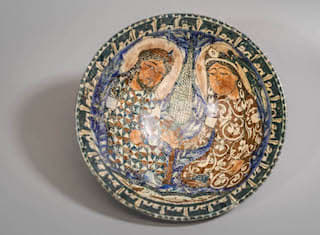Round deep bowl decorated by central figural scene, 13th Century CE - 14th Century CE
Earthenware
RL.21
The Mongol invasions in the second quarter of the 13th century had a severe impact on manufacture and trade in the Middle East. Ceramics production in Iran, and probably Syria,...
The Mongol invasions in the second quarter of the 13th century had a severe impact on manufacture and trade in the Middle East. Ceramics production in Iran, and probably Syria, was greatly disrupted, and only resumed fully in the second half of the century. By this time the establishment of Mongol rule had restored political stability, and had begun to develop extensive contacts and trade throughout Asia. The pottery made in the are which is now modern-day Iran from the second half of the 13th century, although following earlier traditions, is distinctive in its robust shapes and often sombre colouring. Far Eastern patterns, such as lotuses, dragons, and phoenixes, were copied from luxury goods traded to the Middle East and introduced in the decorative repertoire of all arts, including tiles and ceramic vessels. Lustre painting, which had thrived in Iran and Syria in the 12th and early-13th centuries, resumed with a new focus on the production of tiles.
The technique of overglaze enamel painting carried on into the 14th century. Unlike minai ware, however, these later enamelled ceramics primarily featured geometric and vegetal decoration. This was often painted over a dark blue glaze which caused them to be known as lajvardina ware, from the Persian word lajvard (lapis lazuli).
The technique of overglaze enamel painting carried on into the 14th century. Unlike minai ware, however, these later enamelled ceramics primarily featured geometric and vegetal decoration. This was often painted over a dark blue glaze which caused them to be known as lajvardina ware, from the Persian word lajvard (lapis lazuli).
